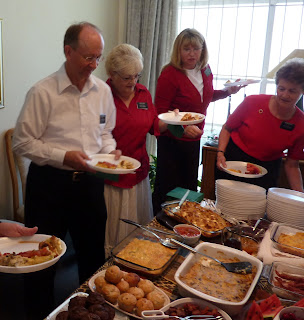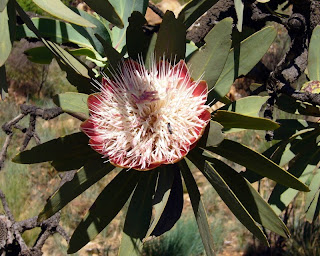On our game drives at Madikwe (22-23 December 2010) some of the most memorable sightings were of unassuming creatures. The seemingly common-looking Red-crested Korhaan is a ground-dwelling bird which exhibited for us his summer aerial display which is considered a marvel of nature. Letting us know we were in his territory this male began a shrill trilling as he began flying straight upward, then silenced and plummeted in a free fall toward the ground before safely catching itself--actions for which it is nicknamed the suicide bird.






Remarkably colorful small birds are the European Roller and Lilacbreasted Roller.
The Dung Beetle is about the size of a silver dollar. This one was rolling a dung ball so quickly with its back legs that we could hardly get a photo of it.
Though small on the trunk of a tree the iridescent Tree Agama (lizard) was easy to spot. Three tortoises moved quickly across a rocky hillside, the two smaller males in pursuit of the female.
In a large meadow area we chatted with a researcher monitoring a radio collared Black Backed Jackal in its pack.
Grazing nearby was a large herd of Springbok.



The most tense and unsettling point of our night drive came when a 350-400 lbs. male arose from the grass and came walking past our open-sided safari vehicle, only six feet from being inside with us! We were assured that if we remained quiet and kept all limbs inside the vehicle we would be ignored by these massive carnivores who have seen tourist vehicles every day of their life.

One of the first sightings on our morning drive was of an elephant nursery with babies and youngsters of all sizes being cared for by females of their herd. The smallest baby was frolicing amidst the others and endearing in its attempts to use its trunk to eat grass.


We were thrilled, at a distance, to see our first Black rhinos in the bush. The mother and baby were very agitated and aggressive.
Elephants are truly amazing. This mud encrusted one walked right over to our vehicle, stopped at about six feet out and just stood looking at us. It was sobering looking into its eyes at our eye level. It then slowly backed away from us and meandered off.


We watched enthralled at the sight of three giraffe who stood in line waiting for their turn to step over a full bush and move back and forth, scratching their chest on the flexible limbs! In the photo the first one is walking away as the second giraffe steps into scratching position and the third waits patiently in que.


Lions are awesome. Muscled and scarred, this breeding pair was observed in a pride of six.
Our safari driver, born and raised in Madikwe, took very good care of us.

























































